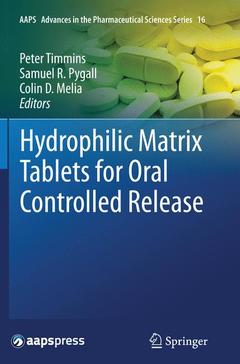Hydrophilic Matrix Tablets for Oral Controlled Release, Softcover reprint of the original 1st ed. 2014 AAPS Advances in the Pharmaceutical Sciences Series, Vol. 16
Coordonnateurs : Timmins Peter, Pygall Samuel R., Melia Colin D.

This detailed volume addresses key issues and subtle nuances involved in developing hydrophilic matrix tablets as an approach to oral controlled release. It brings together information from more than five decades of research and development on hydrophilic matrix tablets and provides perspective on contemporary issues. Twelve comprehensive chapters explore a variety of topics including polymers (hypromellose, natural polysaccharides and polyethylene oxide) and their utilization in hydrophilic matrices, critical interactions impacting tablet performance, in vitro physical and imaging techniques, and microenvironmental pH control and mixed polymer approaches, among others. In one collective volume, Hydrophilic Matrix Tablets for Oral Controlled Release provides a single source of current knowledge, including sections of previously unpublished data. It is an important resource for industrial and academic scientists investigating and developing these oral controlled release formulations.
1 Hydrophilic Matrix Dosage Forms: Definitions, General Attributes and the Evolution of Clinical Utilization.- 2 Design and Evaluation of Hydroxypropyl Methylcellulose Matrix Tablets for Oral Controlled Release: a Historical Perspective.- 3 An Industrial Perspective on Hydrophilic Matrix Tablets based on Hyproxypropyl Methylcellulose (Hypromellose).- 4 Natural Polysaccharides in Hydrophilic Matrices.- 5 Applications of Polyethylene Oxide (POLYOX) in Hydrophilic Matrices.- 6 A Formulation Development Perspective on Critical Interactions Affecting the Performance of Hydrophilic Matrix Tablets.- 7 In vitro Physical and Imaging Techniques to Evaluate Drug Release Mechanisms from Hydrophilic Matrix Tablets.- 8 Physiologically-Based Pharmacokinetic Modelling in the Development and Evaluation of Hydrophilic Matrix Tablets.- 9 Approaches to Rapid In Vivo Optimization of Hydrophilic Matrix Tablets.- 10 Extrusion: an Enabling Technology for Controlled Release Hydrophilic Matrix Systems.- 11 Microenvironmental pH Control and Mixed Polymer Approaches to Optimize Drug Delivery with Hydrophilic Matrix Tablets.- 12 Evolving Biopharmaceutics Perspectives for Hydrophilic Matrix Tablets: Dosage Form-Food Interactions and Dosage Form Gastrointestinal Tract Interactions.
Peter Timmins is Executive Director in Drug Product Science and Technology at Bristol-Myers Squibb Research and Development. His group, based in Moreton, U.K. and New Brunswick, USA, is responsible for creating, adapting, and applying drug delivery technology for oral drug candidates, including those requiring modified release technology. He has a degree in pharmacy and a PhD in pharmaceutical chemistry, both from the University of Bradford in the U.K. Dr. Timmins is a member of the Royal Pharmaceuticals Society of Great Britain. He has many ongoing academic collaborations in the area of oral drug delivery and is a visiting or honorary full professor at the schools of pharmacy at Aston, Bradford and Nottingham in the U.K. He is author or co-author of more than seventy publications, including several books and book chapters, and inventor or co-inventor on thirty patents.
Samuel Pygall is currently an Associate Director and Patient Services Manager at MSD U.K. He was awarded a Master of Pharmacy and a PhD in Pharmaceutical Science from the University of Nottingham in the U.K. Dr. Pygall has a core interest in fostering collaboration between academia and industry to form innovative patient-centric healthcare solutions. He holds a visiting lecturer position at Aston School of Pharmacy in the U.K. and is a U.K.-registered pharmacist, member of the Royal Pharmaceutical Society of Great Britain and past committee member of the United Kingdom and Ireland Controlled Release Society (UKICRS).
Colin Melia is Associate Professor at the School of Pharmacy, University of Nottingham, U.K. He has widely published, provided expert opinions on modified release dosage forms and has been engaged in collaborative research and consultancy with some sixty pharmaceutical and allied companies worldwide. His research group, Formulation Insights, focuses on the elucidation of drug release mechanisms that underlie modifiedrelease behav
Date de parution : 09-2016
Ouvrage de 326 p.
15.5x23.5 cm
Date de parution : 10-2014
Ouvrage de 326 p.
15.5x23.5 cm
Thèmes de Hydrophilic Matrix Tablets for Oral Controlled Release :
Mots-clés :
cellulose ethers; controlled release; drug delivery; excipient; hydrophilic; polymer systems
